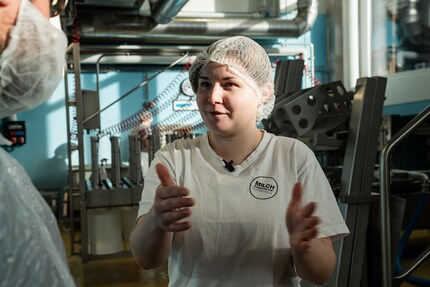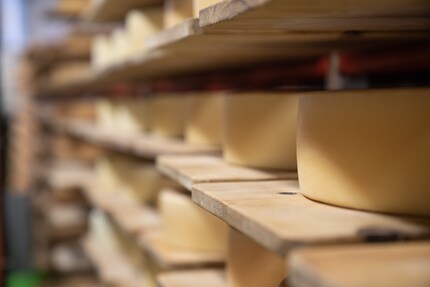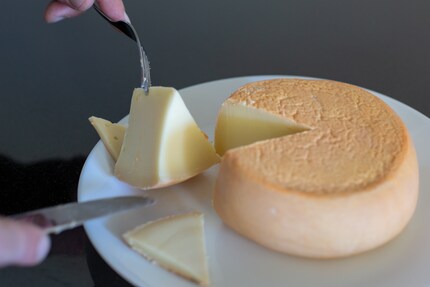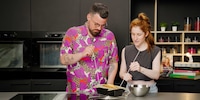
Tour de Suisse: Producing cheese in Einsiedeln
Good cheese is one of those products that I quickly miss when I'm abroad. Without Gruyère, Appenzeller and Emmentaler, I can survive for a week at most. Why is cheese so delicious and how is it made?
There are twenty centimetres of snow on this February morning. I'm looking for the dairy in Einsiedeln in the canton of Schwyz. In my romanticised imagination, the dairy factory is Heidi kitsch: a snow-covered chalet with its own stable and not an industrial complex.
Of course, the dairy industry has arrived in 2019 and the cheese dairy is an industrial building with a flat roof. "I'm Sabrina and today I'm going to show you how to make cheese," says the cheerful show cheesemaker Sabrina Grätzer, greeting me. At least a chalet-style room has been prepared for the visitors. Wooden sections cover the bare concrete wall and the milk for the cheese is already warming up in the pretty copper kettle.
The one with the harp
The goal: to make 8 kilograms of Bergmutschli. This requires 80 litres of milk, a bacterial culture, the enzyme rennet and heat. Sabrina heated the milk to over 30 degrees and added the bacterial culture. The bacteria give the cheese its character and are decisive for the type of cheese. In my case, these are Mutschli bacteria. I add rennet so that the milk solidifies into a mass. Rennet is an enzyme from the calf's stomach and the reason why many cheeses are not actually vegetarian. Don't worry: there is also vegetable or microbial rennet that is safe for vegetarians. The enzyme coagulates the milk, separating it into curds (the dry mass of the milk) and whey (the liquid of the milk, which makes an excellent drink). The curdling process takes around 30 minutes. Then come the strenuous steps: I use the "cheese harp" (a tool that actually resembles a harp) to cut the mass into small pieces. I then have to stir for 20 minutes so that the chopped cheese continues to firm up. If I were a fitness crack, I could now scoop fresh cottage cheese out of the kettle. The consistency of the raw cheese is similar to that of cottage cheese.

I have a back
"Now you have to pull this cloth through the kettle and catch the whole mass with it," says Sabrina and smiles. She knows what comes next: the hard part. I remove a good 12 kilograms of cheese and whey residue from the copper kettle with a cheesecloth. My back is aching. Why didn't I just stay in the office? I put the raw cheese in a plastic mould with a heavy lid on top. The lid squeezes the remaining whey out of the raw cheese. It is now more like silken tofu in consistency and I can cut it into 16 equally sized rectangular pieces. Only now do I give the cheese its shape by placing the 500 gram pieces in round, perforated moulds. A weight presses the liquid out of the cheeses. My job is now done, Sabrina turns the Mutschli a few times over the next few hours before storing them at room temperature overnight.
Wellness for the Mutschli
The next morning, the mutschli are placed in a salt bath for three hours. The water in the large stone pool has a salt content of over 20 per cent. By comparison, the average salt content in the sea is 3.5 per cent. The bath draws even more whey out of the cheese. The longer it takes, the harder the cheese is at the end. After three hours of wellness, it's over: the Mutschli go into the maturing room. This is the treasure trove of every cheese dairy. The cheese wheels are sometimes stored here for over a year. The cheesemaker rubs them with salt water again and again to refine the milk product. My Mutschli are given a four-week break until the semi-hard cheeses find their way to Zurich.

What does the homemade cheese taste like? More flavourful than I'm used to from Mutschli. I like savoury cheese, so it really suits my taste. The rind has suffered a little during transport. The eight kilograms of Mutschli were lost in the post and were sent back and forth between the warehouse in Wohlen and Zurich, without refrigeration. Nevertheless, my Mutschli was very tasty. A glass of white wine, a few pieces of good bread and I had the perfect aperitif.

Would you like to make cheese? The milk factory in Einsiedeln offers cheese-making demonstrations for groups. You can also practise at home with this book.

I travel to Swiss food producers all year round. If you don't want to miss the next instalment of the Tour de Suisse, follow my author profile. You'll receive an email as soon as I publish an article. If you want to try your hand at cheesemaking yourself, I recommend this book.
When I flew the family nest over 15 years ago, I suddenly had to cook for myself. But it wasn’t long until this necessity became a virtue. Today, rattling those pots and pans is a fundamental part of my life. I’m a true foodie and devour everything from junk food to star-awarded cuisine. Literally. I eat way too fast.
Interesting facts about products, behind-the-scenes looks at manufacturers and deep-dives on interesting people.
Show all

